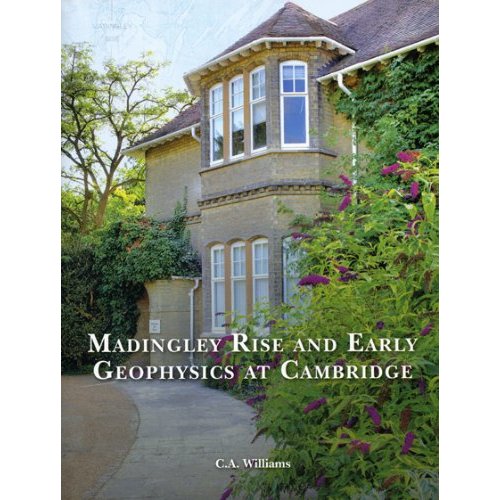“Mad Rise” was short for “Madingley Rise” the address of the Dept of Geodesy and Geophysics at Cambridge University in England. This History of Mad Rise may sound like a Gibbon-like attempt in the History of Geophysics at Cambridge, whose research had a huge impact on the Earth Sciences worldwide. This is a richly illustrated book presented in a superb graphic form.
Its author, Carol Williams has the reputation of being a consummate Indexer of Geophysical papers and also a lady with a penchant for playing with boats: hence her bouncing back, at regular intervals, like a sea buoy, in the existence of the Marine Geophysics Group at Cambridge. The reader of this magnificent opus will not be disappointed therefore to be treated to the detailed life of scientists working at Mad Rise , their foibles and obsessions. This narrative is punctuated by spicy anecdotes, underscored by turf skirmishes, as one might expect of talented people with big egos and unflinching self-confidence. One such instance is illustrated by the case of Sir Gerald Lenox-Conyngham, for 26 years head of department, when being asked, by a Fellow of Trinity College to explain how he came about to be appointed a Reader in Geodesy when in fact he had only a military background in India , Sir Gerald had answered:
because I invented Geodesy!
Well, Aristotle might have had some reservations about it, but then may Sir Gerald be forgiven for missing on a Classics education at the Woolwich Academy. Such an unforgivable lack of a classic education caused Sir Gerald’s signal contribution to Science in general and Cambridge in particular never to be acknowledged with a professorship or some other distinction: he remained an outsider in an otherwise self-centered world.
At this point I must come clean and register a personal interest in Carol’s book, as I am, several times over, a cousin-in-law of Lenox-Conyngham, which is the reason why I bought this expensive volume and not only – one other reason was to discover that special pedigree which all respectable Cambridge Geophysicists take pride in, namely their direct academic lineage to Sir Isaac Newton‘s School of Physics
…
Last but not least I am bound to be nostalgic about that last chapter in Carol’s book which I witnessed at “Mad Rise” as the last PhD student of Sir Edward Bullard. Teddy, a successor of Sir Gerald’s, remained the last towering Head o the Department of Geophysics before it was diluted with Geology and Mineralogy to become the current Department of Earth Sciences. Teddy was always unconventional and enthusiastic about new ideas and steeled my resolve in querying the infallibility of Plate Tectonics dictum, such as the “rigidity” of litospheric Plates in Persia, Tibet and Sinkiang – hence the birth, at Mad Rise, during the early 1970s, of the revolutionary concept of “non-rigid plates”, or “Buffer Plates”: four decades on this new concept gained international acceptance from an otherwise a very conservative and sometimes begrudging profession.
Photo above showing Constantin ROMAN who was Teddy Bullard’s last PhD student in Cambridge, describing, in his rooms at Peterhouse, the extent of the newly-defined Buffer Plates behind the Himalayas, results which he published in the New Scientist and the Geophysical Journal. (Photo Cambridge Evening News, 1973)
Such iconoclastic exercise was not without its dangers in the ruthless rat race of the late 1960s – early 1970s and the chaps from Mad Rise know it too well. Carol Williams apologizes to her contemporaries for leaving out some of their seminal contribution and one must be forgiving and accept her plea in good faith, given the fact that one is compensated by huge helpings about some greats. Even Molly Wisdom is not forgotten: here the larger-than-life persona who, for twenty four years was a Departmental secretary, is afforded not less than seven entries, only to be dispatched variously as a “part-time typist”, a “former opera singer” (with a “shrill voice”…), “chairing” the Common Room table during coffee breaks… It seems as if Molly’s shrewd judgment of human frailties was too close for comfort to some who considered the Department as their sole preserve.
Photo illustration above showing Teddy Bullard, Head of the Geophysics Deopt and his Secretary, Molly Wisdom, at the wedding reception in Cambridge given by Constantin ROMAN, Teddy’s last PhD student in Cambridge. Teddy was immensely supportive and encouraged Roman in defining his concept of “non-rigid litospheric plates” or “Buffer Plates“.
Dan P. Mckenzie, another of Bullard’s students, has generously produced the Preface, the Postface, his raft of scientific papers, reminiscences, his youthful portrait, and more, leaving poor Sir Isaac Newton with the consolation prize of “second best”. But then we suspect that we shall soon benefit from a second edition, where all these `other details left out’ will be included – a thankless task to which I will subscribe. Not bad at all for a first edition, Carol: I give you three out of five.

The History of Geophysics at Cambridge - a good complement to Carol William's book on Madingley Rise
Continental Drift – Colliding Continents, Converging Cultures





No Comments so far ↓
There are no comments yet...Kick things off by filling out the form below.